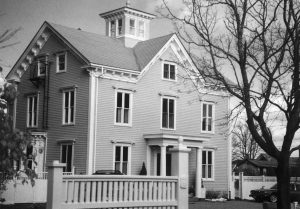In 1998, the Sippican Historical Society commissioned an architectural survey of Marion’s historic homes and buildings. The survey was funded one-half by the Sippican Historical Society and one-half by the Massachusetts Historical Commission. Because of the limits of funding, not all of the historic buildings were surveyed, but over 100 were catalogued and photographed. The results of the survey are in digital form on the Massachusetts Historical Commission’s website and in four binders in the Sippican Historical Society’s office (and at the Marion Town Clerk’s office). Marion (Old Rochester) is one of the oldest towns in the United States, and the Sippican Historical Society maintains an extensive collection of documentation on its historic buildings. The Sippican Historical Society will preview one building a week so that the residents of Marion can understand more about its unique historical architecture. This installment features 13 Cottage Street.
This house was built in 1880 as Taber Hall to house Tabor Academy’s first principal, Clark P. Howland. Mrs. Taber, the founder of the school, called the school “Tabor” after Mount Tabor in the Bible, instead of naming it after herself. Thirteen Cottage Street is an example of the Italianate style of architecture, which was popular in America between the late 1840s and early 1880s. Mr. Howland, a graduate of Yale University, lived on the first floor, while Mrs. Elizabeth P. Taber lived in two rooms on the second floor. Born in Marion in 1791, Elizabeth Pitcher married Stephen Taber, who left her a considerable fortune upon his death in 1862. She then became Marion’s most important benefactress and lived in Taber Hall until her death in 1888 at the age of 97.
